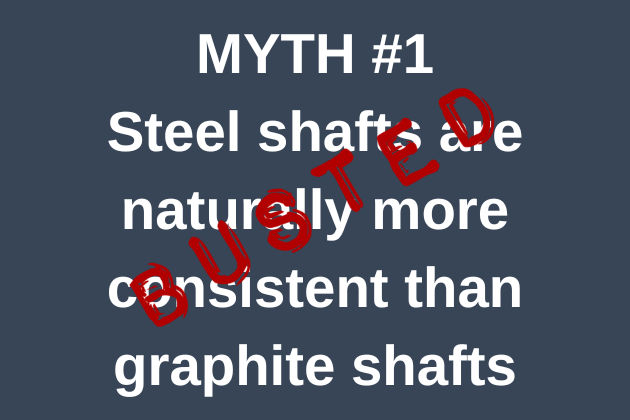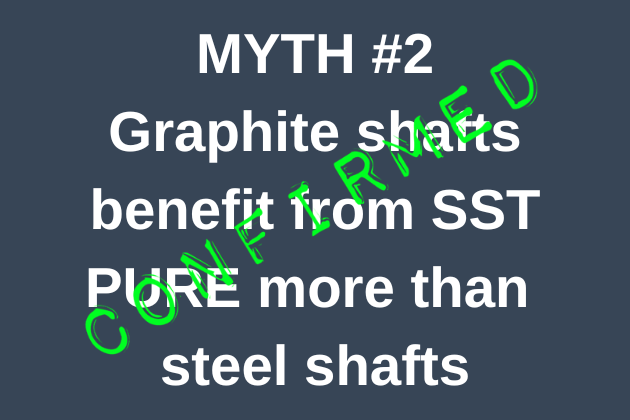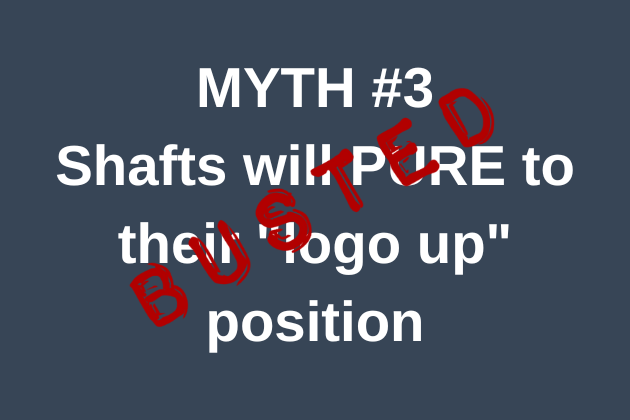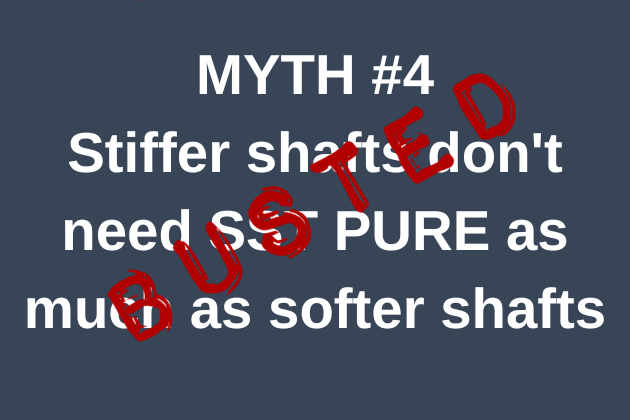The Age-Old Battle: Graphite vs. Steel
Despite decades of success on Tour, SST PURE remains one of the most controversial topics in golf. And since we at Plugged In Golf love nothing more than a spicy comments section, we decided this myth should include not only SST PURE but also the battle between steel and graphite shafts. Is steel more consistent? Does only graphite benefit from SST PURE? Learn all that and more in this edition of Golf Myths Unplugged.
Find our giant SST PURE FAQ HERE
Golf Myths Unplugged puts PUREing to the test HERE
The Myths
Myth #1 – Steel shafts are naturally more consistent than graphite shafts
Myth #2 – Graphite shafts benefit from SST PURE more than steel shafts
Myth #3 – Shafts will PURE to their “logo up” position
Myth #4 – Stiffer shafts don’t need SST PURE as much as softer shafts
How We Tested
For this test, we randomly selected 36 iron shafts from Club Champion’s inventory. They were a mix of graphite and steel representing all flexes, numerous weights, and almost every major manufacturer. Each shaft was SST PUREd, and the results of each PUREing were recorded.
All testing was done at and with the help of Club Champion.
The Results
The first data point produced by the SST PURE machine is the Load Symmetry Index. This is essentially a measure of how round the shaft is, with a perfect score being 100. By this metric, we found no meaningful difference between steel and graphite shafts.
The average for the steel shafts was 95.2; the graphite shafts averaged 94.8. Steel had a slightly larger range, and the best graphite shaft scored a fraction of a percent better than the best steel. Overall, both steel and graphite are impressively consistent.
To test this myth, we looked at the SST PURE’s Out of Plane Oscillation Improvement. This gives us the percentage improvement from the starting position to the PURE position. In our sample, we found that graphite shafts did benefit from SST PURE more than steel shafts.
On average, the graphite shafts we tested improved their out of plane oscillation by 75.2%. The range of improvements ran from 53% to 94.7%. For steel shafts, the average improvement was 64.7% with a range of 46.4% to 79.9%.
While that is interesting, the bigger point is how much SST PURE improves the performance of both steel and graphite. Even the very lowest number in the entire test – 46.4% – is a massive improvement.
This myth was shattered. Among the 18 graphite shafts that we tested, the average SST PURE position was 75 degrees from “logo up.” This means that if players are installing shafts “logo up,” they are often as far as possible from the PURE position!
Two shafts were two degrees from PUREing to a “logo down” position, but no other shafts were with 15 degrees of the logo.
This final myth also bites the dust. In our test group, which included some of the same shafts in different flexes, we saw no correlation between flex and Out of Plane Oscillation Improvement. In fact, a set of regular flex shafts was one of the most consistent in our entire test.
The Takeaway
Modern golf shafts are very high quality products. To consistently produce shafts that are 95% round is an impressive manufacturing feat. However, SST PUREing still makes a significant difference in both graphite and steel shafts.
To borrow an analogy that Nick Sherburne uses, modern golf shafts are like Mercedes automobiles. No one would argue that they aren’t very good. However, it’s similarly inarguable that a Mercedes-AMG is better. SST PURE is that extra step, taking something very good and making it great.
Whether you’re playing steel or graphite, regular flex or extra stiff, SST PURE can help you get the most out of your game.
He founded Plugged In Golf in 2013 with the goal of helping all golfers play better and enjoy the game more.
Matt lives in the northwest suburbs of Chicago with his wife and two daughters.
- Performance Golf Click Stick Training Aid Review - October 18, 2024
- Callaway Opus Platinum Wedge Review - October 17, 2024
- When to Take a Break from Golf - October 15, 2024




















16 Comments
Hi Matt,
I like your conclusion.
There are golfers in favor and others that they do not believe in SST pure.
For me, the F.l.o method gives good results. I never trust a shaft that wobbel in every directions.
If you want a shaft that gives you more chance to hit the sweet spot of the head, you better believe in something more than luck.
Best regards,
Richard
Thanks, Richard.
There’s really no question of belief with SST PURE. The data the machine provides is clear cut. If someone wants to say that they’re happy enough with the shaft as is and they don’t want to pay for it, that’s certainly their right, but that it has an effect is unquestionable.
-Matt
I have played with graphite shafted iron’s for over twenty years now. Finding them more forgiving for someone of a senior age I play of a handicap of 4 and find graphite helps with my joints especially the elbows as you grow older.
The modern shafts are much more reliable than years gone by.
Thanks for the article. I am a firm believer in puring shafts. I have seen the difference that it makes. The dispersion alone is worth it.
Has anyone done a double-blind randomized control trial to see if SST Pure improves accuracy when using a golf robot? You pick a random driver shaft and random iron shaft and do the following test.
100 shots with a driver with unpured shaft.
100 shots with driver with pured shaft (same shaft or at least same model).
100 shots with 7-iron unpured shaft.
100 shots with 7-iron with pured shaft (same shaft or at least same model).
It would not be that hard to do. And the results would provide close to definitive proof one way or the other if SST Pure actually improves dispersion. But I have yet to see any study doing that. So right now the only thing I see is that SST Pure improves the thing it is measuring. But there is no proof that the thing it is measuring results in better dispersion.
Bravo!
/does-pureing-a-shaft-improve-performance-golf-myths-unplugged/
It is amazing to FLO a shaft and see the difference in oscillation from one orientation to another. I can’t say for sure what FLO’ing or PURE’ing a shaft really does when combined with my inconsistent swing, but I prefer building everything as consistently as possible.
I find it difficult to understand whether or not SST PURE shafts PERFORM better than shafts that not have been through the process. All the data above talks about various measurements that are “better” but no context as to what that specifically translates to on course. Todays major manufacturers of graphite shafts have developed very high levels of quality control and I would argue that the nominal differences in PUREd vs UnPUREd shafts in actual playing conditions could not be ascertained by at least 90% of the golfing public.
/does-pureing-a-shaft-improve-performance-golf-myths-unplugged/
I really like the data-driven approach to many articles on this blog. The use of actual golfer data to debunk myths about distance, accuracy, etc. is incredibly interesting and has been useful to my game. However, I’ve got to say that the data presented both in this article and in the earlier article about whether or not PUREing works seems tenuous at best. What is “Out of Plane Oscillation” and what is its effect on the actual golf swing? What data besides a handful of players hitting a handful of shots and then saying which one “felt better” is out there in favor of actual performance improvement from this tech?
Andrew,
We regularly acknowledge the limitations of our sample sizes, which is why we are careful with our conclusions. However, when we see the same thing in almost every player we test, and that matches the results that thousands of golfers have gotten through Club Champion, we feel pretty confident about saying that SST PURE helps.
As to “out of plane oscillation,” it’s not that complicated: the shaft is bent in one direction by the machine, then released. Out of plane oscillation is the shaft moving in different directions than the one it was pushed in (for example, moving NE-SW when it was pushed purely E-W).
Best,
Matt
I had a Bassara shaft SST Pured for my son almost two decades ago and thought It worked well, so well that I had two fairways pured with new shafts and hated the results. Is there a good side and a bad side and can you tell the technician to have it play to the softer side? Because I haven’t done it since, about 14 yrs ago.
Jerry,
You can have the builder do a “soft side” installation.
Best,
Matt
Graphite fishing rod builders have found that this same issue appears in those fishing rods as well, and accuracy of a cast can be improved with truing the blank to the motion of the cast. Little wonder the same hold true for golf shafts. It can be complicated due to manufacturing issues, but with the fishing rod, finding the soft side in the cast , in other words, letting the rod bend in the direction it tends to want to bend, improves consistency.
Kind of hard to know how objective your testing really is when you consider that Club Champion actually owns SST Pure. Massive percentages are also deceiving. Reducing a 0.2 percent error to 0.1 percent error might be a “massive 50 percent improvement, but may be meaningless.